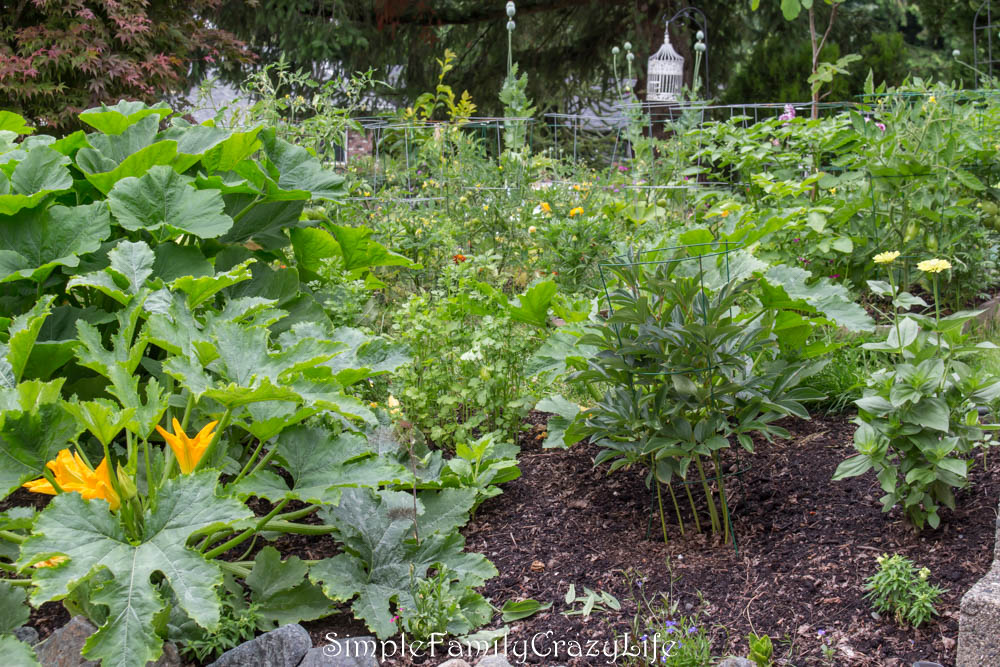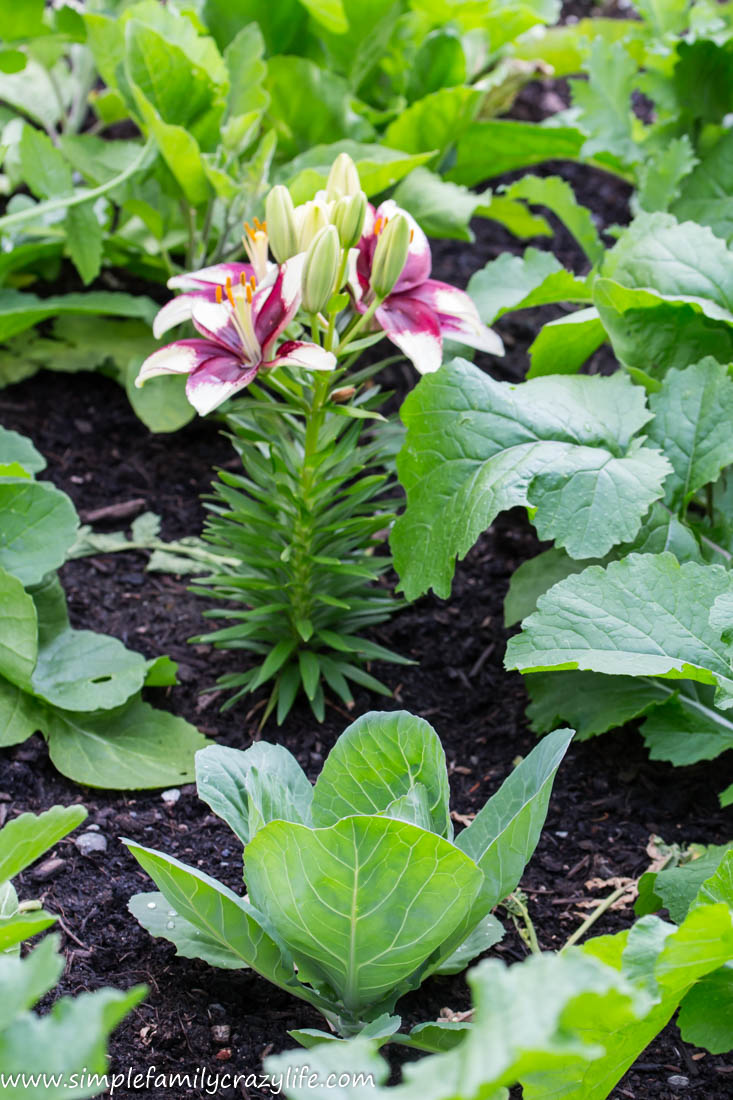This post may contain affiliate links meaning that at no cost to you I may receive a small commission if you make a purchase using my link. I thank you for your support! Please read my DISCLOSURE for more info.
So you are thinking to start an organic garden. I am so happy and excited for you as starting a natural organic garden has so many benefits! We find it very satisfying to be able to grow chemical-free products in our small urban garden. The connection we build with Mother Nature, the delicious veggies and fruit we eat and feed our kids – all that is very important to us! And I hope you will find it fascinating as much as we do as well.
It is not a complicated science that requires a Ph.D. in agriculture.
It is an understanding of a few key components of organic gardening that will help you grow the food you will enjoy eating. I hope you find our tips helpful and enjoy your harvest of delicious organic veggies and fruit!

Benefits of organic gardening
I am sure you’ve heard that eating organic produce is better for your health.
But gardening is also a unique stress-releasing and energizing activity at the same time. It can help you lose weight (we sometimes need to work hard building those raised beds or adding compost to them ;))
Did you also know that natural gardening can improve the environment as well? It helps to create a friendly, healthy environment for living creatures and restore the ecosystem.
You read the articles about the bees population decrease. And the next thing you hear is the new pesticide that the corporations come up with.
But, if you are trying to fight the “bad” insects in your garden with chemicals, you definitely hurt the “good” creatures as well.
With organic gardening, you let nature (with a little bit of help on your side) figure it out.

Attracting beneficial insects, birds and animals, by planting their favourite plants, you create the environment where Mother Nature pays you back with more delicious fruit you can harvest.
Moreover, the delicious fruit, you grow organically, has higher levels of vitamins and minerals than their chemically grown counterparts.
That means that you and your family get more of the best 😉
Isn’t it the best?
What kind of organic garden can you start?
So, now you are probably wondering what kind of organic garden you can have. And whether you live on an acreage or in a small apartment, the answer will be different.
It will also be different if you live in the hot climate of Mexico (I am so jealous!) or in the North Pole.
But you can still have it anyway!
It will probably be somewhat complicated to grow avocados in a small apartment in the North Pole 😉
But you can definitely grow tons of greens on a windowsill there.
We live in Canada.

Well, we live in the warmest part of Canada but we still get snow and cold snaps here as well. We have built a greenhouse in the backyard, but since it is not a heated greenhouse, the raised beds stay frozen for a couple of winter months.
That means we cannot grow anything there during that time. It warms up when it is sunny. But sunny days usually happen when it is freezing cold outside.
When it warms up outside, it usually rains. So it is still cold inside the greenhouse then.
So, what do we do in winter?
We grow microgreens!
You can check this post for more information on how we do it. But my point is that even in Canada when you cannot grow anything outside as the grounds are frozen, you can still have fresh greens for your salad.

And, by the way, they are extremely nutritious (1)!
So, instead of buying them in the store, you can easily grow them indoors.
So, let look at some of the options you may consider for your organic garden
You Can Start a Container Garden
If you have limited space, or simply rent a place and don’t want (or are not allowed) to make any permanent changes to the current layout of your backyard, then growing your own herbs or vegetables in containers is a great option for you.
Tomatoes, peppers, eggplants, greens, almost anything can be grown in containers. Many times you can find free containers on sites like Craiglist, which makes it more affordable.

With additional lighting, you can harvest some cherry tomatoes even in winter if you grow them indoors!
And you can take containers with you if you need to move to a different place.
There are a few things to be aware of with a container garden:
- containers you use: you can build your own using the materials you can easily find or upcycle, or, as mentioned above, you can find some inexpensive clay, plastic or wooden second-hand containers on Craiglist. Just make sure to thoroughly clean them before use;
- drainage is very important. You don’t want your plants’ roots rotting. If there are no drainage holes in a container, you can drill some. We would put tape on both sides of the container where we want the hole to make sure it doesn’t break;
- soil – we use the same soil mix for most of the vegetables we grow. We make it ourselves using the coconut coir (2 parts), worm castings and compost (2 parts), perlite and vermiculite (1 part of each). Some plants may have specific soil requirements so you need to adjust.
I’ve also heard pretty good reviews about the Garden Tower containers. I am yet to get one for myself. I think it is a perfect option for those who love green salads but have limited space! (the image below is clickable and has my affiliate link to the product).
Raised beds
Growing vegetables in the raised beds is a great option if you have a smaller garden. It required some initial investment to build them, though you can always use the materials you have on hand or can easily find them for free. We share a few posts on how we built our raised beds on our blog.


The flower bed on the image above creates a separation between the garden and the playground. We built it last year along with the arbour.
The grass on the left side looks dead as the image was taken during a period of drought we had last summer. With water restrictions and all that fun.
But, as you can see the garden still looks pretty good.
There are many more benefits to the raised beds garden.
First, it is ergonomically easier to work with the raised surface. Second, you can enhance the soil by adding compost without the need for tilling.
If you have kids, they will enjoy having their own little garden where they can plant whatever they want and take care of their plants 🙂 With the raised bed it will be easier for them to not step on the plants they grow 😉
Hydroponic garden
Have you ever tried to regrow onions or celery in water without soil?
That is a very simplified idea of the hydroponic garden. We haven’t tried it on a larger scale ourselves yet. But it is definitely an option if your only gardening space is a small indoor space.
You can build the system yourself or buy a starter kit online.
Select the site for your organic garden
If you are lucky enough to have a corner in your backyard or a front yard that you can designate for a garden, your next step is to assess it.
What do I mean by that?
What you choose to grow there will possibly depend on the amount of sun that corner gets. The amount of sun might also be different depending on the season and your geographical location.
You don’t want to start an organic garden in a complete shade but you can still grow organic veggies in part-shade.
Another thing to consider when starting a garden is the surface contours. Is your yard flat or sloped? How is drainage there? Our backyard is flat. We use wood bark mulch instead of grass between the raised beds.
Yours might be on a slope, and you will need to take that into consideration. You can still build the raised beds on the slope. It will just require a little more of planning and work.
We have utilized the slope in our front yard replacing the lawn to grow more flowers and attractive vegetables like squash and eggplants, as that area gets the most of the sun during the day.
Our friend called it “Jurassic Park”. Look at those huge squash plants there! Because the soil was generously amended with lots of compost, everything grew so well there!


Do you need to amend the soil?
How to test and improve your soil
As I have already mentioned above, the soil is a very important component for growing healthy plants.
Different plants require different nutrients for growth and production. how to find what your soil is like? My blogging friend Julie from the Dogwoods and Dandelions has a great post on how to test your garden soil.
We only use compost to amend the soil in our garden. In spring, we usually buy a few yards of organic compost that we add to the raised beds.
We’ve built the compost bins as well. But it is still not enough for our growing garden.
Also, we have a small box with red wigglers worms. Their castings are the “black gold”. My hubby treats those worms almost like his own children 🙂 He talks to them and only gives them the best food scraps from our kitchen 🙂
How to attract beneficial insects and birds to your garden
What are the beneficial insects and why do we want them in the garden?
Beneficial insects are the little garden helpers that we want to welcome to our gardens. They pollinate the plants so we can get fruit. They feed on aphids or lay their eggs on caterpillars so they don’t eat our leafy veggies. And the list is going on and on.

Ladybugs, bees, praying mantis, spiders, lacewing – are just a few that you are probably familiar with already.
So, how do we attract them to the garden?
- plant flowers. Because our garden is pretty small (less than 1,000 sq. ft), and I love flowers, I just grow them in the raised beds amongst the vegetables. Allysum, borage, rosemary, and beebalm are some of the great flowers to grow to attract the bees. Milkweed is a great plant to attract butterflies, especially the Monarch butterflies. Red Scarlet Beans are very attractive to hummingbirds. We love observing those tiny birds in our garden!
- add bird feeders in winter. While it is easier for birds to find food in the garden during the warmer season, there is not much for them to eat in winter. We let many of the garden plants go to seed and leave them in the garden. Birds can munch on the seeds and the plants add interest in the garden creating “structural” viewpoints.
- add a water source. It doesn’t have to be a fountain or a creek. A small plate or a birdbath can make it. A cute birdbath also adds interest to the garden, and we do want our gardens to not only be useful but beautiful as well 😉 Don’t we?
- add a bee-house. You can find them in a nursery or online. But I heard you could also bury an old teapot in the ground with only nose-tip sticking out. I am definitely going to try this summer! Remember, bees, unlike wasps, won’t sting you, unless you hurt them. But if you or someone in your family is allergic to bee-sting, you may want to have the bee-house set at the farthest corner of the garden.
In harmony with Nature
There are many things to take into consideration when you start your organic garden. My best advice for you is to start small.
We have moved to our house at the end of 2015. The previous owners didn’t seem to use the backyard for anything but the playground for their dog. The weeds felt pretty comfortable growing almost undisturbed there.
So, Mr. Handyman built 2 raised beds in March, and that was when our love for gardening has begun. We were so encouraged by the plants grown in those 2 beds the first season!
Summer squash, pattypans, cauliflower, broccoli, tons of lettuce and kale – all that was growing happily in the new generously composted beds 🙂

Every season we have been adding more and more raised beds both in the backyard and in the front yard. And the older shed has been transformed into a greenhouse.
We have planted a few fruit trees and are planning to add more in the upcoming years.

You see? It doesn’t have to be all done at once.
Take your time. It needs to be an enjoyable process!
If you have kids, get them to help you. Gardening is a great educational process as well. Pizza doesn’t grow on trees 🙂
And berries, peas and tomatoes (and many other veggies and fruit) taste sooooo good straight from the garden!
So, what do you think?
Are you ready to start an organic garden?
Do you have any questions or do you want to see a post about a specific gardening topic? Don’t be shy, just post a comment below, and I will try to answer it for you 🙂
Feel free to sign-up for my newsletter as well using the form below.









